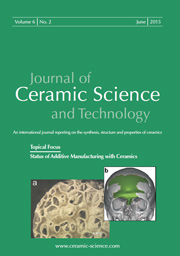Articles
All articles | Recent articles
New Si/B/N/C Ceramics from a Silaborazine-Type Single-Source Precursor
H. Cakmak, M. Jansen
Max Planck Institute for Solid State Research, Heisenbergstrasse 1, 70569 Stuttgart, Germany
received November 25, 2010, , accepted December 2, 2010
Vol. 2, No. 1, Pages 23-30 DOI: 10.4416/JCST2010-00044
Abstract
A new chloro-substituted monocyclic silaborazine derivative with a B/Si-ratio of 2, namely 1,1,3,5-tetrachloro-2,6-dimethyl-4-hydride-1-silaborazine (TDSB), has served as a single-source precursor for the synthesis of amorphous Si/B/N/C ceramics via the well-known „polymer route”. Accordingly, ammonia and methylamine were used as cross-linking reagents for polymerization of TDSB, leading to highly homogeneous pre-ceramic polymers, which were characterized with spectroscopic methods. In addition, subsequent thermal degradation of as-obtained polyborocarbosilazanes was monitored by means of DTA/TG/MS up to 1350 °C. The resulting amorphous ceramics exhibit excellent thermal durability up to 2000 °C under inert conditions. This is attributed to silaborazine rings (originating from the TDSB precursor molecule) still being present in the covalent Si/B/N/C network and reinforcing the final ceramics on atomic scale by acting as rigid structural units.
![]() Download Full Article (PDF)
Download Full Article (PDF)
Keywords
Silaborazine, single-source precursor, pre-ceramic polymer, precursor-derived ceramic, Si/B/N/C ceramics
References
1 Baldus, H.-P., Wagner, O., Jansen, M.: Synthesis of advanced ceramics in the systems Si-B-N and Si-B-N-C employing novel precursor compounds, Mater. Res. Soc. Symp. Proc., 271, 821-826, (1992).
2 Baldus, P., Jansen, M., Sporn, D.: Ceramic fibers for matrix composites in high-temperature engine applications, Science, 285, 699-703, (1999).
3 Baldus, H.-P., Jansen, M: Novel high-performance ceramics – amorphous networks from molecular precursors, Angew. Chem., Int. Ed. Engl., 36, 328-343, (1997).
4 Riedel, R., Kienzle, A., Dressler, W., Ruwisch, L., Bill, J., Aldinger, F.: A silicoboron carbonitride ceramic stable to 2000 °C, Nature, 382, 796-798, (1996).
5 Jansen, M., Jäschke, B., Jäschke, T.: Amorphous multinary ceramics in the Si-B-N-C system, Struct. Bonding, 101, 137-191, (2002).
6 Jäschke, T., Jansen, M.: Improved durability of Si/B/N/C random inorganic networks, J. Eur. Ceram. Soc., 25, 211-220, (2005).
7 Jäschke, T., Jansen, M.: A new borazine-type single source precursor for Si/B/N/C ceramics, J. Mater. Chem., 16, 2792-2799, (2006).
8 Haberecht, J., Krumeich, F., Grützmacher, H., Nesper, R.: High-yield molecular borazine precursors for Si-B-N-C ceramics, Chem. Mater., 16, 418-423, (2004).
9 Haberecht, J., Nesper, R., Grützmacher, H.: A construction kit for Si-B-N-C ceramic materials based on borazine precursors, Chem. Mater., 17, 2340-2347, (2005).
10 Schurz, F., Jansen, M.: Borazine based molecular single source precursors for Si/B/N/C ceramics, Z. Anorg. Allg. Chem., 636, 1199-1205, (2010).
11 Roth, A., Jansen, M.: Silicon Borocarbonitride Ceramics from Polycyclic Precursor Compounds, Processes for Producing Them and Use, (in German), German Patent Application DE 10 2006 013 469 A1, (2006).
12 Epple, A.: Synthesis and Characterization of New Single-Source Precursors and Ceramics in the Si/B/N/C System and Solid-State NMR Investigations of Isotope-Labelled SiBN3C, (in German), Ph.D. thesis, University of Stuttgart, (2006).
13 Cakmak, H., Jansen, M.: Synthesis and characterization of a new silaborazine derivative, Z. Anorg. Allg. Chem., 637, 25-28, (2011).
14 Wilfert, J., Meier, K., Hahn, K., Grin, Y., Jansen, M.: SiC/BN composites by spark plasma sintering (SPS) of precursor-derived SiBNC powders, J. Ceram. Sci. Tech., 1, 1-6, (2010).
15 Nöth, H., Tinhof, W., Taeger, T.: Silaborazines Derived from Cyclosilazanes, (in German), Chem. Ber., 107, 3113-3120, (1974).
16 Kroschel, M.: Amorphous B/Si/C/N-High-Performance Ceramics Derived from Single-Source Precursors, (in German), Ph.D. thesis, University of Bonn, (2001).
Copyright
© 2010 Göller Verlag
Acknowledgments
The authors are grateful to M.-L. Schreiber for supporting preparative and analytical work, and to J. Wilfert and T. Pilz for DTA/TG/MS measurements.


